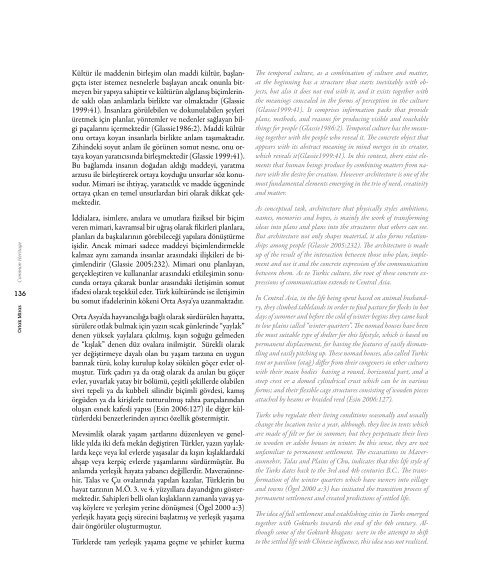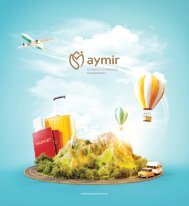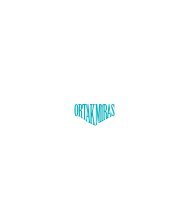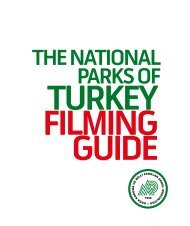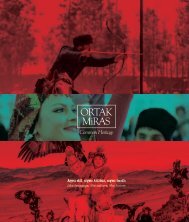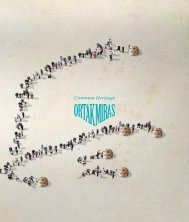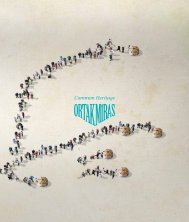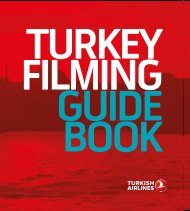Create successful ePaper yourself
Turn your PDF publications into a flip-book with our unique Google optimized e-Paper software.
Common Heritage<br />
136<br />
Ortak Miras<br />
Kültür ile maddenin birleşim olan maddi kültür, başlangıçta<br />
ister istemez nesnelerle başlayan ancak onunla bitmeyen<br />
bir yapıya sahiptir ve kültürün algılanış biçimlerinde<br />
saklı olan anlamlarla birlikte var olmaktadır (Glassie<br />
1999:41). İnsanlara görülebilen ve dokunulabilen şeyleri<br />
üretmek için planlar, yöntemler ve nedenler sağlayan bilgi<br />
paçalarını içermektedir (Glassie1986:2). Maddi kültür<br />
onu ortaya koyan insanlarla birlikte anlam taşımaktadır.<br />
Zihindeki soyut anlam ile görünen somut nesne, onu ortaya<br />
koyan yaratıcısında birleşmektedir (Glassie 1999:41).<br />
Bu bağlamda insanın doğadan aldığı maddeyi, yaratma<br />
arzusu ile birleştirerek ortaya koyduğu unsurlar söz konusudur.<br />
Mimari ise ihtiyaç, yaratıcılık ve madde üçgeninde<br />
ortaya çıkan en temel unsurlardan biri olarak dikkat çekmektedir.<br />
İddialara, isimlere, anılara ve umutlara fiziksel bir biçim<br />
veren mimari, kavramsal bir uğraş olarak fikirleri planlara,<br />
planları da başkalarının görebileceği yapılara dönüştürme<br />
işidir. Ancak mimari sadece maddeyi biçimlendirmekle<br />
kalmaz aynı zamanda insanlar arasındaki ilişkileri de biçimlendirir<br />
(Glassie 2005:232). Mimari onu planlayan,<br />
gerçekleştiren ve kullananlar arasındaki etkileşimin sonucunda<br />
ortaya çıkarak bunlar arasındaki iletişimin somut<br />
ifadesi olarak teşekkül eder. Türk kültüründe ise iletişimin<br />
bu somut ifadelerinin kökeni Orta Asya’ya uzanmaktadır.<br />
Orta Asya’da hayvancılığa bağlı olarak sürdürülen hayatta,<br />
sürülere otlak bulmak için yazın sıcak günlerinde “yaylak”<br />
denen yüksek yaylalara çıkılmış, kışın soğuğu gelmeden<br />
de “kışlak” denen düz ovalara inilmiştir. Sürekli olarak<br />
yer değiştirmeye dayalı olan bu yaşam tarzına en uygun<br />
barınak türü, kolay kurulup kolay sökülen göçer evler olmuştur.<br />
Türk çadırı ya da otağ olarak da anılan bu göçer<br />
evler, yuvarlak yatay bir bölümü, çeşitli şekillerde olabilen<br />
sivri tepeli ya da kubbeli silindir biçimli gövdesi, kamış<br />
örgüden ya da kirişlerle tutturulmuş tahta parçalarından<br />
oluşan esnek kafesli yapısı (Esin 2006:127) ile diğer kültürlerdeki<br />
benzerlerinden ayırıcı özellik göstermiştir.<br />
Mevsimlik olarak yaşam şartlarını düzenleyen ve genellikle<br />
yılda iki defa mekân değiştiren Türkler, yazın yaylaklarda<br />
keçe veya kıl evlerde yaşasalar da kışın kışlaklardaki<br />
ahşap veya kerpiç evlerde yaşamlarını sürdürmüştür. Bu<br />
anlamda yerleşik hayata yabancı değillerdir. Maveraünnehir,<br />
Talas ve Çu ovalarında yapılan kazılar, Türklerin bu<br />
hayat tarzının M.Ö. 3. ve 4. yüzyıllara dayandığını göstermektedir.<br />
Sahipleri belli olan kışlakların zamanla yavaş yavaş<br />
köylere ve yerleşim yerine dönüşmesi (Ögel 2000 a:3)<br />
yerleşik hayata geçiş sürecini başlatmış ve yerleşik yaşama<br />
dair öngörüler oluşturmuştur.<br />
Türklerde tam yerleşik yaşama geçme ve şehirler kurma<br />
The temporal culture, as a combination of culture and matter,<br />
at the beginning has a structure that starts inevitably with objects,<br />
but also it does not end with it, and it exists together with<br />
the meanings concealed in the forms of perception in the culture<br />
(Glassie1999:41). It comprises information packs that provide<br />
plans, methods, and reasons for producing visible and touchable<br />
things for people (Glassie1986:2). Temporal culture has the meaning<br />
together with the people who reveal it. The concrete object that<br />
appears with its abstract meaning in mind merges in its creator,<br />
which reveals it(Glassie1999:41). In this context, there exist elements<br />
that human beings produce by combining matters from nature<br />
with the desire for creation. However architecture is one of the<br />
most fundamental elements emerging in the trio of need, creativity<br />
and matter.<br />
As conceptual task, architecture that physically styles ambitions,<br />
names, memories and hopes, is mainly the work of transforming<br />
ideas into plans and plans into the structures that others can see.<br />
But architecture not only shapes material, it also forms relationships<br />
among people (Glassie 2005:232). The architecture is made<br />
up of the result of the interaction between those who plan, implement<br />
and use it and the concrete expression of the communication<br />
between them. As to Turkic culture, the root of these concrete expressions<br />
of communication extends to Central Asia.<br />
In Central Asia, in the life being spent based on animal husbandry,<br />
they climbed tablelands in order to find pasture for flocks in hot<br />
days of summer and before the cold of winter begins they came back<br />
to low plains called “winter quarters”. The nomad houses have been<br />
the most suitable type of shelter for this lifestyle, which is based on<br />
permanent displacement, for having the features of easily dismantling<br />
and easily pitching up. These nomad houses, also called Turkic<br />
tent or pavilion (otağ) differ from their congeners in other cultures<br />
with their main bodies having a round, horizontal part, and a<br />
steep crest or a domed cylindrical crust which can be in various<br />
forms; and their flexible cage structures consisting of wooden pieces<br />
attached by beams or braided reed (Esin 2006:127).<br />
Turks who regulate their living conditions seasonally and usually<br />
change the location twice a year, although, they live in tents which<br />
are made of felt or fur in summer, but they perpetuate their lives<br />
in wooden or adobe houses in winter. In this sense, they are not<br />
unfamiliar to permanent settlement. The excavations in Maveraunnehir,<br />
Talas and Plains of Chu, indicates that this life style of<br />
the Turks dates back to the 3rd and 4th centuries B.C.. The transformation<br />
of the winter quarters which have owners into village<br />
and towns (Ögel 2000 a:3) has initiated the transition process of<br />
permanent settlement and created predictions of settled life.<br />
The idea of full settlement and establishing cities in Turks emerged<br />
together with Gokturks towards the end of the 6th century. Although<br />
some of the Gokturk khagans were in the attempt to shift<br />
to the settled life with Chinese influence, this idea was not realized.


